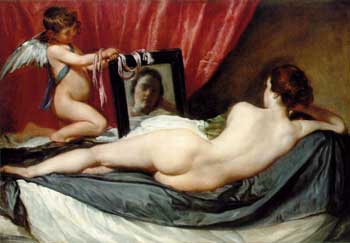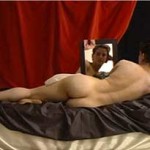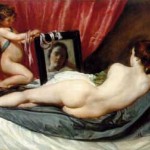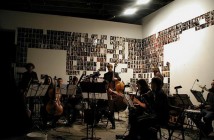In Venus at Her Mirror, a well-known painting by Diego Velasquez, Venus reclines on a sofa with her back to the viewer. She’s looking back at the viewer in a mirror held by Cupid. Her face is unclear and it seems we are attempting to voyeuristically peer in on the scene. Is she aware of us? Or merely vainly admiring her own image, being the goddess of beauty and all. Has she fallen under her own spell? And more importantly, is this setting, in this pose, Is this a specifically ‘male’ view of the goddess? Of women?
Mary Ellen Strom takes classic paintings, such as Venus... and restages them in videos with contemporary women artists. She’s trying to rexamine how these famous works have been interpreted, and provides an alternative for understanding. Is this the typical ‘male gaze’ viewpoint? Was this provacative portrait only tolerated by the church because of its mythological subject? Or, as Mary Ellen Strom proposes, can this be seen as a moment of reflection. A natural moment of self examination. To examine and even be happy with what they are confronted with . To ultimately become a subject rather than an object.
The women cast in these live reenactments, begin with this idea, and through meditiation and other processes, try to empower themselves as subject. The scene is meticulously lit, the participants moving imperceptibly. The video is shown at the scale of the original work they are depicting. These pieces take time to absorb and It’s startling to suddenly see the subject of an ‘artwork’ deliberately staring back at you, returning your gaze. It’s impossible not to question everything that goes along with looking, the inconspicuous politics of the gaze.
_
At her recent gallery talk at Judi Rotenberg gallery, Mary discussed some of her ideas behind the recent videos as well as overall concepts behind her body of work.
Links:
Judi Rotenberg Gallery
All images are courtesy of the Mary Ellen Strom and Judi Rotenberg Gallery.






